.
Chevrolet Nova: Difference between revisions
No edit summary |
No edit summary |
||
| Line 1: | Line 1: | ||
[[Image:Nova front fender emblem 68-72.jpg|right|350px]] | [[Image:Nova front fender emblem 68-72.jpg|right|350px]] | ||
The '''[[Chevrolet]] Nova''', or '''Chevy II''', was an American compact car introduced by [[General Motors]] in 1962. The original Chevy II was of unibody construction, powered by an OHV inline four or six-cylinder engine, and available in two- and four-door sedan configurations as well as convertible and station wagon versions. After the rear-engine [[Chevrolet Corvair]] was handily outsold by the conventional [[Ford Falcon]] in 1960, Chevrolet began work on a more conventional compact car that would eventually become the Chevy II. The Chevy II/Nova continued on throughout the 1960s and 70s with great success until it was supplanted by the front wheel drive [[Chevrolet Citation|Citation]] in 1980. The Nova name would reappear briefly again in 1985 as a twin to (of all things) the [[Toyota Corolla]]. The "Toyolet" Nova was discontinued after 1988, replaced by the [[Geo | The '''[[Chevrolet]] Nova''', or '''Chevy II''', was an American compact car introduced by [[General Motors]] in 1962. The original Chevy II was of unibody construction, powered by an OHV inline four or six-cylinder engine, and available in two- and four-door sedan configurations as well as convertible and station wagon versions. After the rear-engine [[Chevrolet Corvair]] was handily outsold by the conventional [[Ford Falcon]] in 1960, Chevrolet began work on a more conventional compact car that would eventually become the Chevy II. The Chevy II/Nova continued on throughout the 1960s and 70s with great success until it was supplanted by the front wheel drive [[Chevrolet Citation|Citation]] in 1980. The Nova name would reappear briefly again in 1985 as a twin to (of all things) the [[Toyota Corolla]]. The "Toyolet" Nova was discontinued after 1988, replaced by the [[Geo Prizm]]. | ||
{| border=0 cellspacing=0 cellpadding=4 style="float:right; margin:0 0 .5em 1em; width:250px; background:#fff; border-collapse:collapse; border:1px solid #999; font-size:83%; line-height:1.5; " summary="Infobox Automobile" | {| border=0 cellspacing=0 cellpadding=4 style="float:right; margin:0 0 .5em 1em; width:250px; background:#fff; border-collapse:collapse; border:1px solid #999; font-size:83%; line-height:1.5; " summary="Infobox Automobile" | ||
| Line 256: | Line 256: | ||
The LN was replaced with the Nova Concours in 1976, and the Custom model was gone (temporarily). The grille was changed slightly, and the short-lived 262 V8 was replaced by the new 5.0L (305 cid) V8 and was standard on the Concours. The 350 V8 remained the top engine option. Transmissions included the 3-speed manual standard with the I6, with a 4-speed manual or 3-speed automatic optional. The 305 could have a 4-speed manual or automatic, while the 350 was automatic only. 1977 Concours models got a new 3-taillight lens scheme very similar to the larger [[Chevrolet Impala|Impala]] with a [[Cadillac]]-esque front clip that included chrome squared-off headlight bezels and a more elegant-looking vertically-barred grille with extra chrome trim. The SS was dropped, but it would continue as the '''Nova Rally''', which was basically the same sporty-themed idea. | The LN was replaced with the Nova Concours in 1976, and the Custom model was gone (temporarily). The grille was changed slightly, and the short-lived 262 V8 was replaced by the new 5.0L (305 cid) V8 and was standard on the Concours. The 350 V8 remained the top engine option. Transmissions included the 3-speed manual standard with the I6, with a 4-speed manual or 3-speed automatic optional. The 305 could have a 4-speed manual or automatic, while the 350 was automatic only. 1977 Concours models got a new 3-taillight lens scheme very similar to the larger [[Chevrolet Impala|Impala]] with a [[Cadillac]]-esque front clip that included chrome squared-off headlight bezels and a more elegant-looking vertically-barred grille with extra chrome trim. The SS was dropped, but it would continue as the '''Nova Rally''', which was basically the same sporty-themed idea. | ||
1978 Novas continued with little change, other than the Custom model returning as the base model. | 1978 Novas continued with little change, other than the Custom model returning as the base model. The 2-door, 3-door hatchback and 4-door sedan bodystyles, and Concours and Rally models, were still available. By now the Nova was starting to fall out of favor with much of the buying public, largely due to increased competition from the new [[Ford Fairmont]] and even Chevrolet's own [[Chevrolet Malibu|Malibu]], which was an all-new downsized model for 1978. Even though 1979 was a final abbreviated model year, the front end was nonetheless revised again with square headlights and a new horizontally-barred grille for the short run. The 9C1 police package was dropped for '79, along with the Rally model and 350 V8 engine. Production ended on December 22, 1978. The Nova was replaced by the all-new front wheel drive [[Chevrolet Citation|Citation]] for 1980. The Nova name, however, would reappear again in 1985 on an unrelated model. | ||
{{-}} | {{-}} | ||
| Line 310: | Line 310: | ||
==1985-1988 Nova== | ==1985-1988 Nova== | ||
In 1985 the Nova name was applied to a rebadged [[Toyota Corolla]] and was produced at the NUMMI plant in Fremont, California, as an historic first joint venture between [[General Motors]] and [[Toyota]]. | In 1985 the Nova name was applied to a rebadged [[Toyota Corolla]] and was produced at the NUMMI plant in Fremont, California, as an historic first joint venture between [[General Motors]] and [[Toyota]]. It shared the Corolla's drivetrain and running gear, and was available as a 4-door sedan and a 5-door hatchback (just like the Corolla). It differed from the Corolla mainly with slightly different front-end styling. It also shared many interior parts, such as audio systems, with other GM's offerings whereas the Corolla did not. The Corolla had been redesigned for 1988, but the Nova continued to use the old platform for one year. The 1990 Geo Prizm was related to the new Corolla. | ||
{{-}} | {{-}} | ||
Revision as of 18:13, 10 August 2008
The Chevrolet Nova, or Chevy II, was an American compact car introduced by General Motors in 1962. The original Chevy II was of unibody construction, powered by an OHV inline four or six-cylinder engine, and available in two- and four-door sedan configurations as well as convertible and station wagon versions. After the rear-engine Chevrolet Corvair was handily outsold by the conventional Ford Falcon in 1960, Chevrolet began work on a more conventional compact car that would eventually become the Chevy II. The Chevy II/Nova continued on throughout the 1960s and 70s with great success until it was supplanted by the front wheel drive Citation in 1980. The Nova name would reappear briefly again in 1985 as a twin to (of all things) the Toyota Corolla. The "Toyolet" Nova was discontinued after 1988, replaced by the Geo Prizm.
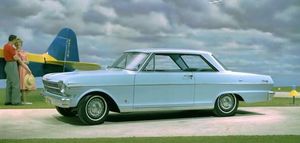
| |
| Chevy II/Nova | |
|---|---|
| Chevrolet | |
| Production: | 1962-1965 |
| Class: | Compact |
| Body Style: | 2-Door Coupe 4-Door Sedan 2-Door Convertible 5-Door Wagon |
| Length: | 153" 157.4" (wagon) |
| Width: | |
| Height: | |
| Wheelbase: | 110" |
| Weight: | 2800-3100 lbs |
| Transmissions: | 3-Speed Manual, RWD 4-Speed Manual, RWD 2-Speed Automatic, RWD 3-Speed Automatic, RWD |
| Engines: | 2.5L (153 cid) I4 (1962-1965) 3.2L (194 cid) I6 (1962-1965) 3.8L (230 cid) I6 (1964-1965) 4.7L (283 cid) V8 (1964-1965) 5.3L (327 cid) V8 (1965) |
| Power: | 90-300 hp |
| Similar: | N/A |
| Platform: | X |
First Generation (1962-1965)
Three different levels of this car were made - the Chevy II 100, the Chevy II 300 and the Chevy II Nova 400. Available powerplants included the standard 2.5L (153 cid) I4 and optional the 3.2L (194 cid) I6. Although the 1st gen Nova was not originally available with a V8 option, the engine bay was perfectly proportioned for one. It wasn't long before Chevrolet V8s were offered as dealer-installed options (between 1962 and 1963), up to and including the fuel injected version available in the Chevrolet Corvette. The combination of readily available V8 power and light weight made the Nova a popular choice of drag racers.
For 1963, the Chevy II Nova Super Sport (SS) was released. As previously mentioned, Novas could not "officially" have V8 engines at this time — the standard SS engine was the six-cylinder — but many ended up with a small-block V8 under the hood. In 1962 and 1963 the Nova was available in a convertible body style, and a two-door hardtop was available from 1962-1965. For 1964, the Chevy II's first factory V8 option was introduced - a 195 hp 4.7L (283 cid) V8. The convertible was dropped, and the SS was also dropped at the beginning of this year, but it was reinstated mid-year due to high popular demand. The 300 series trim level was discontinued, leaving the 100 and 400 levels. In 1965, the grille was redesigned and the parking lights were relocated from directly below the headlights to the bumper. Taillights were revised also. The 5.3L (327 cid) V8 debuted this year in the SS with up to 300 horsepower.
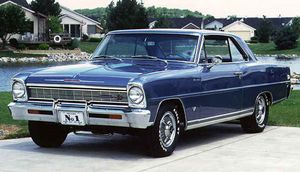
| |
| Chevy II/Nova | |
|---|---|
| Chevrolet | |
| Production: | 1966-1967 |
| Class: | Compact |
| Body Style: | 2-Door Coupe 4-Door Sedan 5-Door Wagon |
| Length: | 154.7" 157.4" (wagon) |
| Width: | |
| Height: | |
| Wheelbase: | 110" |
| Weight: | 2800-3100 lbs |
| Transmissions: | 3-Speed Manual, RWD 4-Speed Manual, RWD 2-Speed Automatic, RWD 3-Speed Automatic, RWD |
| Engines: | 2.5L (153 cid) I4 (1966-1967) 3.2L (194 cid) I6 (1966-1967) 3.8L (230 cid) I6 (1966-1967) 4.1L (250 cid) I6 (1967) 4.7L (283 cid) V8 (1966-1967) 5.3L (327 cid) V8 (1966-1967) |
| Power: | 90-350 hp |
| Similar: | N/A |
| Platform: | X |
1966 Novas saw a significant restyling, based in part on the Super Nova concept car. In general, proportions were squared up but dimensions and features changed little. Engine options still included the basic 153 I4, 194 I6 and the 283 and 327 V8s, the latter offering now offering up to 350 horsepower, making the Nova so-equipped quite a pocket rocket during the musclecar era. During this time, the 90 hp 153 I4 was only offered in the base Chevy II 100 series models with the 120-horsepower 194 cubic-inch six standard on the Nova and Nova SS lines. In addition to the V8s, other optional engines included a 140 hp 3.8L (230 cid) I6 and a 155 hp 4.1L (250 cid) I6, the latter a new offering for 1967. The 350 hp L79 327 V8 was unfortunately dropped for 1967.
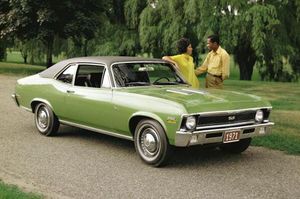
| |
| Chevy II/Nova | |
|---|---|
| Chevrolet | |
| Production: | 1968-1974 |
| Class: | Compact |
| Body Style: | 2-Door Coupe 3-Door Coupe 4-Door Sedan |
| Length: | |
| Width: | |
| Height: | |
| Wheelbase: | |
| Weight: | 3000-3400 lbs |
| Transmissions: | 3-Speed Manual, RWD 4-Speed Manual, RWD 2-Speed Automatic, RWD 3-Speed Automatic, RWD |
| Engines: | 2.5L (153 cid) I4 (1968-1970) 4.1L (250 cid) I6 (1968-1974) 5.0L (307 cid) V8 (1968-1973) 5.7L (350 cid) V8 (1968-1974) 6.5L (396 cid) cid V8 (1968-1970) 7.0L (427 cid) V8 (1970) |
| Power: | 90-425 hp |
| Similar: | Buick Apollo Oldsmobile Omega Pontiac Ventura |
| Platform: | X |
Second generation (1968–1974)
An extensive redesign came in 1968, when the station wagon and two door hardtop were discontinued. This body style continued (with a minor restyle in 1973) through 1974. One notable change was the front subframe assembly — as compared with Ford, Chrysler and AMC, in whose cars the entire front suspension was integrated with the bodyshell, a separate subframe housing the powertrain and front suspension (similar to the front part of the frame of GM's full-size, full-framed vehicles) replaced the earlier style. Although the front subframe design was a Chevy II-exclusive design, the Camaro introduced a year earlier was the first to incorporate such a design; the redesigned Chevy II was pushed a year back to 1968 instead of 1967. 1968 was the final year that the Chevy II nameplate was used, although all 1968 models were "Chevy II Novas" with one single trim line.
The standard 153 I4 was offered between 1968-1970, then was dropped due to lack of interest. Far more popular were the 250 I6 and the new 5.0L (307 cid) V8, which replaced the 283 offered in previous generations. At mid-year a semi-automatic transmission based on the Powerglide called Torque-Drive was introduced as a low-cost option for shiftless motoring for both the four and six-cylinder engines. The two-speed Powerglide was still the only fully-automatic gearbox available with most engines as the more desirable three-speed Turbo Hydra-Matic was only available with the largest V8 engines.
The SS was transformed from a trim package to a performance option for 1968 and now included a 295 hp 5.7L (350 cid) V8 engine along with front disc brakes, heavy-duty suspension and other performance hardware. Optional engines included two versions of the big-block 6.5L (396 cid) V8 rated at 350 and 375 hp. Both 396 engines were offered with a choice of transmissions including the M-21 close-ratio four-speed manual, the M-22 heavy-duty "Rock Crusher" four-speed manual, or the three-speed Turbo Hydra-Matic 400 for those who preferred automatic shifting.
1969
The Chevy II nameplate was retired and the car became the "Chevy Nova" for this year (some sources referred to it as the Chevrolet Chevy Nova - perhaps the decision to drop the Chevy II moniker was a last-minute decision for 1969). Like other 1969 GM vehicles, locking steering columns were incorporated. Simulated vents were added below the Nova script, which was relocated to the front fender instead of the rear quarter panel. The 350 V8 with four-barrel carburetor that came standard with the SS option was revised with a five-hp increase to 300 while a two-barrel carbureted version of the 350 V8 rated at 255 hp was a new option on non-SS models. A new Turbo Hydra-Matic 350 three-speed automatic was made available for non-SS Novas with six-cylinder and V8 engines.
1970
Basically a carryover from 1969; the side markers and taillight lenses were wider and positioned slightly differently, which placed the reverse lights in the middle of the taillight lens instead of the inward portion. This was the final year for the SS396. All other engines were carried over including the seldom-ordered four-cylinder which was in its final year. The car finally became simply the Chevrolet Nova this year after two years of transitional nameplates (Chevy II Nova in 1968 and Chevrolet Chevy Nova in 1969).
Approximately 177 COPO Novas were ordered, with 175 converted by Yenko Chevrolet (the other two were sold in Canada). These had the mighty 7.0L (427 cid) V8 engine that was also shared with the COPO Chevrolet Chevelle and Camaro.
A beater 1970 Nova coupe is prominently featured in the movie Beverly Hills Cop.
1971
1971 Novas were similar to the previous year but with the loss of the simulated fender vents and the discontinuation of the 396 motor for the SS with the L48 350 taking its place. 1971 also saw the introduction of the Rally Nova, a trim level that only lasted two years and was marketed as sort of a budget-SS. The Rally package included black or white stripes that ran the length of the car and around the back, a Rally Nova sticker on the driver's side of the hood, and Rally wheels.
The 250 I6 was now the standard Nova powerplant with the demise of the 153 I4 and 230 I6 engines. The 307 and 350 V8s were carried over from 1970 and all engines featured lowered compression ratios to enable the use of unleaded gasoline as a result of a GM corporate mandate that took effect with the 1971 model year.
After 1971, other GM divisions began rebadging the Nova as their new entry-level vehicle, such as the Pontiac Ventura II (once a trim option for full-size Pontiacs to 1970), Oldsmobile Omega (1973) and the Buick Apollo (mid-1973). Interestingly, the intials of the four model names spelled out the acronym NOVA (Nova, Omega, Ventura, Apollo.)
1972
A virtual rerun of 1971, the 1972 Nova received only minor trim changes and both the Rally Nova and SS options carried over. At mid-year a manual canvas sunroof option became available on two-door models. Also, the optional Strato bucket seats available on coupes switched from the previous low-back design with adjustable headrests to the high back units with built-in headrests introduced the previous year on Camaros and Vegas.
1973
The 1973 model year introduced a new hatchback bodystyle based on the 2-door coupe, as well as a front and rear restyling and a modified rear side window shape, plus a revised rear suspension adapted from the second-generation Camaro with multi-leaf springs replacing the mono-leaf springs used on Novas since the original 1966 model. A luxury-themed Nova Custom became part of the model lineup which included upgraded upholstery, full carpeting and more exterior trim. By this time, six-cylinder and V8 engines were de rigeur for American compact cars, with the 307 and 350 (5.0 and 5.7L) V8s becoming fairly common. Nova SS models offered a higher-performance 350 (5.7L) V8. The 1973 Nova with a six-cylinder engine or 307 V8 were among the last Chevrolets to be offered with the now-outdated two-speed Powerglide automatic transmission, which was in its final year.
1974
For 1974, the powerglide was replaced by a lightweight version of the three-speed Turbo Hydra-Matic 350 already offered with the 350 V8, which was now the only V8 offered this year. The SS option was still available but became more of a sporty trim package than a performance offering and now offered with any Nova engine, much like the 1963-67 Nova SS.
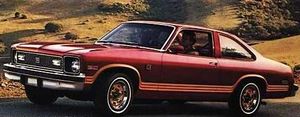
| |
| Chevrolet Nova | |
|---|---|
| Chevrolet | |
| Production: | 1975-1979 |
| Class: | Compact |
| Body Style: | 2-Door Coupe 3-Door Coupe 4-Door Sedan |
| Length: | |
| Width: | |
| Height: | |
| Wheelbase: | |
| Weight: | 3000-3400 lbs |
| Transmissions: | 3-Speed Manual, RWD 4-Speed Manual, RWD 3-Speed Automatic, RWD |
| Engines: | 4.1L (250 cid) I6 (1975-1979) 4.3L (262 cid) V8 (1975) 5.0L (305 cid) V8 (1976-1979) 5.7L (350 cid) V8 (1975-1978) |
| Power: | 110-170 hp |
| Similar: | Buick Skylark Cadillac Seville Oldsmobile Omega Pontiac Ventura/Phoenix |
| Platform: | X |
Third generation (1975–1979)
A completely redesigned Nova was introduced in 1975. Bodystyles were still the 2-door coupe, 3-door hatchback and 4-door sedans. Base coupes, including the hatchback, had fixed side windows (or optional flip-out windows) and simulated vertical vents on the B-pillar (sedans would have simulated horizontal vents at the bottom of the C-pillar). Engines this year were the standard 250 I6 carried over from the previous generations, a 4.3L (262 cid) V8 and 350 V8 were optional. The front suspension and subframe assembly was similar to the one used in the second-generation GM F-body (Camaro, Firebird), whereas the rear axle and suspension were carried over from the 1968-74 generation.
The Nova lineup now ranged from the stripped-down "S" model, base, Custom, and the luxury-themed LN (the LN, or "Luxury Nova", was one of the first cars to sport metric displacement badges — either "4.3 LITRE" or "5.7 LITRE"). The Nova SS continued for 1975 and got a unique grille with horizontal parking lights versus the vertical units beside the headlights. A high-performance 9C1 police version of the Nova was introduced for the 1975 model year, making it the first compact car certified for police duty in the U.S. Most were initially purchased by the Los Angeles County Sheriff's Department in 1976.
The LN was replaced with the Nova Concours in 1976, and the Custom model was gone (temporarily). The grille was changed slightly, and the short-lived 262 V8 was replaced by the new 5.0L (305 cid) V8 and was standard on the Concours. The 350 V8 remained the top engine option. Transmissions included the 3-speed manual standard with the I6, with a 4-speed manual or 3-speed automatic optional. The 305 could have a 4-speed manual or automatic, while the 350 was automatic only. 1977 Concours models got a new 3-taillight lens scheme very similar to the larger Impala with a Cadillac-esque front clip that included chrome squared-off headlight bezels and a more elegant-looking vertically-barred grille with extra chrome trim. The SS was dropped, but it would continue as the Nova Rally, which was basically the same sporty-themed idea.
1978 Novas continued with little change, other than the Custom model returning as the base model. The 2-door, 3-door hatchback and 4-door sedan bodystyles, and Concours and Rally models, were still available. By now the Nova was starting to fall out of favor with much of the buying public, largely due to increased competition from the new Ford Fairmont and even Chevrolet's own Malibu, which was an all-new downsized model for 1978. Even though 1979 was a final abbreviated model year, the front end was nonetheless revised again with square headlights and a new horizontally-barred grille for the short run. The 9C1 police package was dropped for '79, along with the Rally model and 350 V8 engine. Production ended on December 22, 1978. The Nova was replaced by the all-new front wheel drive Citation for 1980. The Nova name, however, would reappear again in 1985 on an unrelated model.
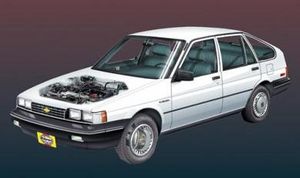
| |
| Chevrolet Nova | |
|---|---|
| Chevrolet | |
| Production: | 1985-1988 |
| Class: | Compact |
| Body Style: | 4-Door Sedan 5-Door Sedan |
| Length: | |
| Width: | |
| Height: | |
| Wheelbase: | |
| Weight: | 2500-2700 lbs |
| Transmissions: | 5-Speed Manual, FWD 3-Speed Automatic, FWD |
| Engines: | 1.6L (97 cid) I4 |
| Power: | |
| Similar: | Toyota Corolla |
| Platform: | S |
1985-1988 Nova
In 1985 the Nova name was applied to a rebadged Toyota Corolla and was produced at the NUMMI plant in Fremont, California, as an historic first joint venture between General Motors and Toyota. It shared the Corolla's drivetrain and running gear, and was available as a 4-door sedan and a 5-door hatchback (just like the Corolla). It differed from the Corolla mainly with slightly different front-end styling. It also shared many interior parts, such as audio systems, with other GM's offerings whereas the Corolla did not. The Corolla had been redesigned for 1988, but the Nova continued to use the old platform for one year. The 1990 Geo Prizm was related to the new Corolla.
Photos
Main Competitors 1962-1979
- Studebaker Lark
- Dodge Dart/Aspen
- Ford Falcon/Maverick/Fairmont
- Ford Granada
- Mercury Comet/Zephyr
- Mercury Monarch
- Plymouth Valiant/Volare
Main Competitors 1985-1988
- Dodge Omni
- Ford Escort
- Honda Civic
- Isuzu I-Mark
- Mazda 323
- Mercury Lynx
- Nissan Sentra
- Plymouth Horizon
- Volkswagen Golf
The urban legend
A popular urban legend asserts that the Nova sold poorly in Mexico and other Latin American countries because the phrase no va means "does not go" in Spanish. In reality, the Spanish language no va and nova are as different as the English no table and notable, or therapist and the rapist. [1] The word nova exists in Spanish with the same meaning as in English. Also, the Spanish word for 'new' (nuevo or nueva) is cognate to nova, which originally meant "new" in Latin. Finally, as NOVA was a brand of gasoline sold for many years by PEMEX in Mexico, the largest of all Spanish-speaking Latin American countries, it is clear that this urban legend, while perhaps entertaining, is utterly baseless.
See Also
External links
- National Nostalgic Nova The original National Nostalgic Nova Club Celebrating 25 Years of Helping Nova People The only Monthly Magazine dedicated to Only Novas!
- Chevrolet Nova Internet Source — The second known Nova site on the Internet
- Nova listserv — The first and only known public mailing list dedicated to Chevrolet Novas and other X-bodies; in continuous existence since January 1998
- Automotive History Online - Chevrolet Nova History & Photos
- NovaResource.com — Excellent source of history, production numbers, and option code information for 1962-79 Novas
- Steve's Nova Site - Includes Q&A discussion board; another excellent resource for Nova owners
- Chevy Nova SS at Muscle Car Facts — A year-by-year history.
- Gen4Novas.com — Source for the 'stepchild' Disco-era X-car.


